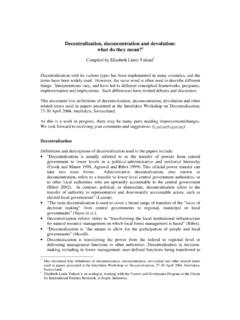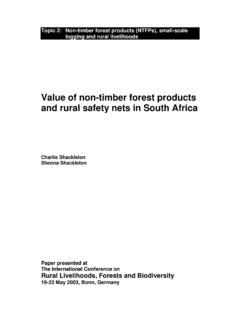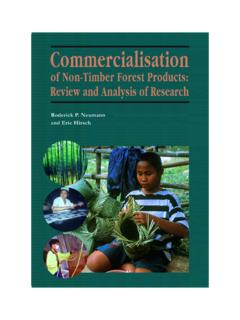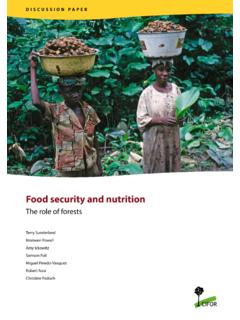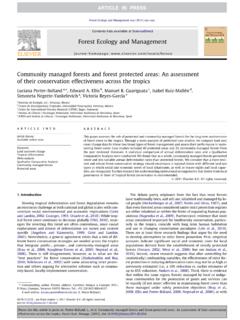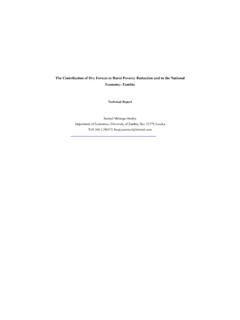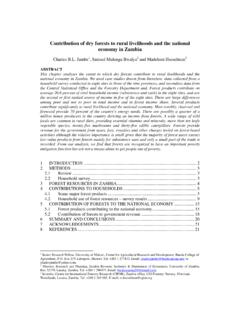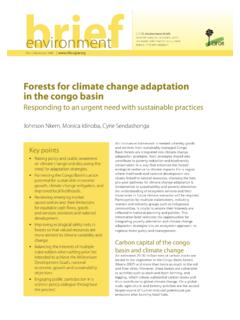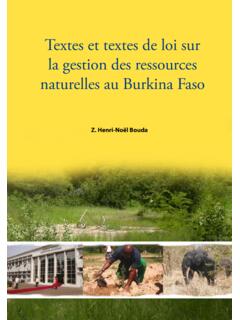Transcription of Land-use change and its influence on rural …
1 3 Land-use change and its influence on rural livelihoods, food security and biodiversity conservation in the Southwest Region of CameroonStella Asaha and Liz DeakinSummaryThis scoping study aims to give a preliminary overview of historical land uses, the underlying drivers of Land-use change and the impacts on rural communities in the Nguti area of Southwest Cameroon. The information presented in this report was gathered through a literature review, collection of secondary data and scoping field visits. A reconnaissance survey, community meetings and participatory rural appraisals were undertaken in three focal villages in the Nguti district. This area has experienced a number of changes in land use over the last 100 years and is currently experiencing a new wave of change in the form of large-scale agro-industrial oil palm development.
2 Until recently, the land use has been small-scale household swidden agriculture with traditional shifting cultivation and fallowing, secondary forest of different stages, food crop farmlands, and cocoa IntroductionCameroon is located in West Africa and shares borders with Nigeria, Chad, Equatorial Guinea, Gabon, Central African Republic and Republic of Congo (Figure ). It has a mix in vegetation ranging from the tropical rainforests typical of the Congo Basin Land-use change and its influence on rural livelihoods, food security and biodiversity conservation in the Southwest Region of Cameroon 55countries, to the savanna/Sahel grasslands typical of West African countries such as Burkina Faso. Cameroon offers a rare diversity of ecosystems, mountains, littoral and marine coastlines, and has a great diversity of people and cultures.
3 The total land area of Cameroon is about 47 million ha and some type of forest (including both dense and mixed forests) covers 59% of the land (WRI, 2013). The overall Land-use figures in Cameroon are classified as: forest area ( million ha), arable land ( million ha), permanent crops (1400 million ha), others including permanent meadows and pasture land ( million ha) (FAO 2013).Between 2000 and 2005, the rate of forest change in Cameroon was estimated at per annum. This was primarily due to timber exploitation (legal and illegal) and land clearing for agricultural activities and mining (WRI 2013). Cameroon has an estimated population of about 20 million (UN 2014). It is estimated that about 85% of the population are employed in the agricultural sector and the majority of people live in rural areas where there is a significantly higher rate of population increase.
4 The economic crisis that hit Cameroon in the late 1980s and 1990s left many young people jobless, with no option but to settle on farming as a means of fighting poverty, (personal communication from S Abia, 2013). In the early 2000s, an increase in cocoa prices gave farmers a strong motivation for expansion of their income from cocoa. These factors greatly contributed to the expansion of the agricultural sector and simultaneously increased forest degradation and deforestation. Cameroon has also become the breadbasket of its neighbors, especially Gabon and Equatorial Guinea, which have a high demand for Cameroonian food crops such as cassava, cocoyams, plantains and banana. According to Sneyd (2014), the cross-border trade in Cameroonian banana, manioc and plantains engaged in by Gabonese and other buyam-sellam traders is seen by many to be an additional source of price pressure on traditional staples.
5 This cross-border trade seems to be on the rise (Sneyd 2013). These lucrative external markets have encouraged high levels of food crop cultivation in all regions of the country. The establishment of large-scale agro-industrial palm oil plantations has recently taken place in Cameroon as a result of the government s quest to become an emerging economy by 2035 (MINEPAT 2009). The Southwest Region of Cameroon in particular has undergone significant changes in Land-use patterns and practices, from primary forest, foraging for NTFPs, and swidden agricultural practices for coffee (Coffea arabica and C. robusta) and cocoa (Theobroma cacao) to timber exploitation and more recently, establishment of agro-industrial plantations. The fertile soils, available land and high prices of cocoa have greatly contributed to the changes in Land-use patterns by local farmers.
6 It is now becoming increasingly common for farmers to alter their agricultural practices and begin growing oil palm (Elaeis guineensis). Planting a few stands of oil palm on the farm has been a common practice on farms to provide palm oil and palm wine for domestic consumption. During the last 7 years however, farmers have begun to establish oil palm plantations on a medium scale, producing palm oil for the local Cameroonian market. In addition to the smallholder oil palm farmers, two main agro-industries have been operating within the region for almost 100 years: CDC (Cameroon Development 56 Agrarian change in tropical landscapesFigure Map of Cameroon. Source: Ezilon (2013) Land-use change and its influence on rural livelihoods, food security and biodiversity conservation in the Southwest Region of Cameroon 57 Corporation) and PAMOL.
7 There is now a new multinational palm oil company in the southwest area of Cameroon; SG-SOC (Sithe Global Sustainable Oils Cameroon Ltd.) in partnership with Herakles Farm, a US company. Their initial negotiation with the government gave them access to about 70,000 ha of land, which covered two divisions of the Southwest Region. While there is no question that oil palm is a highly lucrative crop that can contribute to economic development, the conversion of native forests for plantations places a heavy toll on the environment (Hance and Butler 2011). These plantations bring ecological, sociocultural, economic and demographic changes as well as other related issues linked to human settlement and livelihoods. BackgroundThe purpose of this scoping study is to provide background information on a selected study area (Nguti) in the Southwest Region of Cameroon in order to understand the processes and impacts related to Land-use change in the region.
8 Research was focused on four main areas of interest, each following specific objectives: 1. Description of the study area What is the geographical, social, cultural, political, economic and ecological context of the study area?2. Land use: Changes, drivers and impacts What are the current types of land use in the landscape? What are the local and external historical events/drivers that have influenced land cover, land use and land management in the study area? 3. Interventions affecting land use in the study area What interventions have influenced land use/land cover in the landscape? What are the motivations/expected outcomes of the intervention in terms of participation, food security , livelihoods and biodiversity in the landscape?4. Livelihoods, food security and nutrition What is the current livelihood, food security and nutrition situation in the study area?
9 Research methodsInformation presented in this report is based on: secondary data sources and the wider literature, which was consulted to gather background information on the Southwest Region of Cameroon and the Nguti study area a scoping field research study carried out in the Nguti-Manyemen region during November/December 2013. A grounded theory approach (Glaser 2013) was implemented in settlements in the study area to gather information on Land-use practices, food security issues and livelihoods. A reconnaissance survey, community meetings and participatory rural appraisals (Liswanti and Basuki 2009) were undertaken in three focal Agrarian change in tropical Reconnaissance survey and site selectionThe reconnaissance survey involved a 5-day trip to the study area where previously identified villages were visited.
10 During this time, all of the villages within the project area were visited and three focal villages were selected for the purpose of the scoping study: Ayong, Babensi I and Babensi II (Figure ). These villages were selected based on their easy accessibility compared to others in the study area. GPS coordinates were taken for each Map of villages in Nguti study area, Southwest Region, : Map produced by E Kuchambi, Independent GIS Expert, October Methods undertaken in each villageInitial community meetingsIn each of the three villages, a meeting was held with the chief, council and other elders of the village to introduce the research team to them. A subsequent meeting was held with the entire community to provide a detailed explanation of the research objectives and of structured questionnairesStructured questionnaires were administered to a sample of the households.
